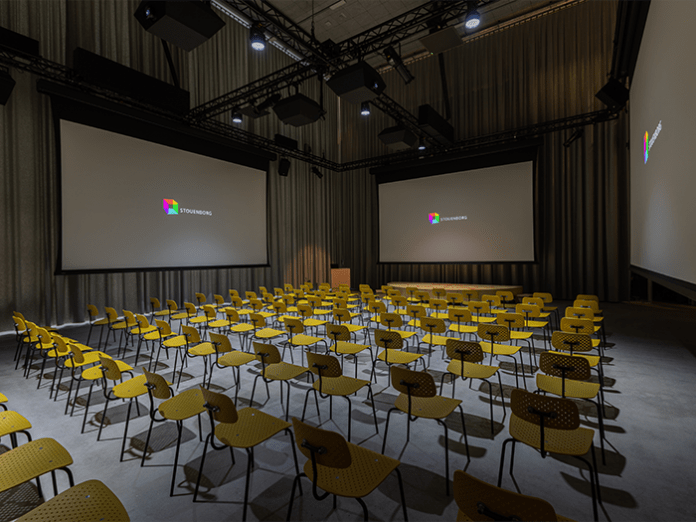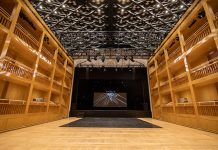Opened for instruction late in 2021, the new Aarhus School of Architecture in Denmark is uniquely equipped to educate future architects in all elements — aural as well as visual — of contemporary building design. Among the most prestigious institutions of its kind in Europe, the Aarhus School of Architecture was established in 1965. Prior to construction of the new campus, the learning facilities were spread out across the city in nine separate locations.
The new four-story main campus building brings together all nine addresses under one roof and leverages advanced AV technologies to provide optimum classroom communication and remote learning opportunities, including a Meyer Sound Constellation acoustic system in the main auditorium that allows students to directly experience the acoustic response of various room designs. The school’s extraordinary investment in advanced AV technologies for learning was made possible by funding from the A.P. Møller and Chastine Mc-Kinney Møller Foundation.
The consultancy and integration firm Stouenborg was tasked with the design, engineering, and installation of all AV systems at the school, with Anders Jørgensen serving as project manager. According to Jørgensen, one of the principal goals was to make sure cutting-edge technology was applied to enhance communication and not impose annoying hinderances. A prime example is the acoustical flexibility afforded by Constellation, a sophisticated system of active acoustics comprising 13 D-Mitri network platform modules along with 71 small full-range loudspeakers and 14 compact subwoofers.
“Here we have a large auditorium that often functions as a lecture hall,” says Jørgensen, “and with Constellation we can create a teaching environment that is optimized for effortless two-way communication. It breaks the natural flow of a presentation when you must pass a wireless microphone around for student questions. With Constellation’s voice lift and Q&A feature, you have clear two-way communication — just as if you were in a small classroom.”
Aarhus School of Architecture Prorector Kristine Leth Juul appreciates the changed psychology afforded by the new technology. “It supports the idea that lectures can be dialogue-based, where it becomes easy to ask questions. Students can feel safer to ask questions, giving them more courage to get involved and even stimulate lively debates it creates more equality in the space.”
Although it was not part of the original assignment, a common understanding was quickly reached that the acoustic flexibility in Constellation could be used as a tool to strengthen the didactic foundation to teach the architecture students and give the student an idea of what acoustics mean in a teaching environment.
“Traditionally, teaching of acoustics in architecture schools is conceptual and visually descriptive,” Jørgensen says. “A professor can explain how changing a room size, shape or materials will affect room acoustics, but the students cannot hear the differences. Now, with Constellation, various room designs can be modeled acoustically, clearly demonstrating how different architectural choices will impact room acoustics.”
A smaller learning environment, dubbed didaktek (from the Greek roots of “teach” and “technology”) provides a different flavor of immersive learning experience with projection screens on all four walls. Each screen is paired with a Meyer Sound ULTRA-X40™ loudspeaker which localizes the sound source to the active screen. If desired, sound can be panned from screen to screen, or even moved spatially anywhere in the room, using Meyer Sound’s new iPad-based Spacemap® Go spatial sound design and mixing tool. Two USW-210P™ subwoofers extend bandwidth as needed for low-frequency impact.
If desired, a moveable partition between the auditorium and didaktek can be pulled back to form an open space with seating space for as many as 400. The Constellation system has special settings that enable the two rooms to also blend seamlessly as a single coherent acoustical response.
“It is clear that the potential for use of these rooms is far wider than we expected because the flexibility and acoustics are so good,” comments Kristine Leth Juul. “This means staff members can experiment and take full advantage of each system’s possibilities. I expect this will be broadly inspiring, not only for our own students but also for the many guests and international architects who come to visit.”
Seven smaller rooms were each outfitted with two Meyer Sound UP-4slim™ loudspeakers. “These rooms are often used for streaming presentations or interactive seminars on Zoom or other platforms,” says Jørgensen. “Since the remote voice microphone pickup can vary widely, high intelligibility in the room was vital. With the UP-4slims we have an STI [speech transmission index] rating between 0.83–0.92.”
The many spaces in the new building have already proven flexible and robust in both design and use during the week-long festivities that celebrated the opening with an architectural festival with both Danish and international guest lectures visiting.





